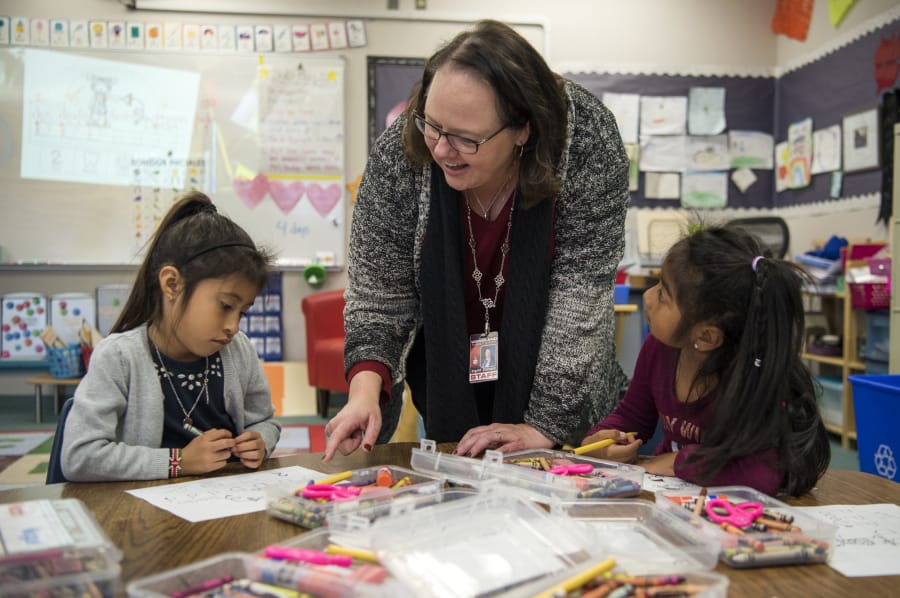WOODLAND — Anahisse Hodge knows the feeling of being tugged in two directions.
She grew up the youngest of three kids in a Spanish-speaking home in Portland, but when she arrived in kindergarten, she was told she couldn’t speak Spanish at all and struggled to talk to classmates.
She knew a little English from her older siblings, but not much. As she became more comfortable with English, she used it more at home, but her mother wanted to speak to her only in Spanish.
“She didn’t want me to forget it,” Hodge said.
Hodge continued to learn English while it became harder for her parents, both from Mexico, to understand her schoolwork. She saw how hard it was for them to feel welcome coming to her school.
Now, Hodge is part of a team at Woodland Primary School working to break down that language barrier not only for students in the classroom, but for parents at home. Hodge is one of two teachers in the school’s new dual-language program, which kicked off at the start of the school year.
“I have those (English language learner) experiences,” Hodge said. “I know what it’s like to get pulled out during fun activities to go to ELL because they don’t want you to miss important instructional time.”
The school recently received a $34,000 grant from the state Office of Superintendent of Public Instruction for the program, which will be used to purchase teaching and learning materials. The goal for the program is to make sure students are bilingual and biliterate.
The program has 44 kindergarten students spread across two classes. Each class is filled with roughly half native Spanish speakers and half native English speakers. Half of the day is in Spanish and half of the day is in English, and students didn’t need any knowledge of the other language to enter the program.
Hodge and Jill Thoeny, the other dual-language teacher, wear a red scarf when it’s time to speak in Spanish and a blue scarf to show students to use English. Students can break language to ask questions or help each other, but Hodge and Thoeny keep using the language scheduled for that part of the day.
“To hear their home language around school brings comfort,” said Thoeny, who is in her fourth year teaching at the school. “I see they feel more comfortable in their smiles and participation around school.”
Hodge is in her second year at the school. Before Hodge was hired, Thoeny was the only teacher in the school who spoke Spanish, and often times had Spanish-speaking parents coming in to talk to her, even if she wasn’t their child’s teacher.
Principal Ingrid Colvard said more than 25 percent of incoming kindergarten students to her school come from Spanish-speaking homes, so making those families feel more welcome was a priority for school officials. According to the census’ 2012-2016 American Community Survey, the most recent data available, 16 percent of Woodland residents who responded to the survey said they speak Spanish. That was the highest percentage of any city in Clark County, followed by Vancouver’s 9.1 percent and then 5.5 percent in La Center, according to the survey results.
Colvard and Thoeny talked about a dual-language program the last few years, partly because they thought the Woodland community would benefit from it and partly because studies showed that students in dual-language programs see academic gains after a few years, especially in reading and reclassification of English language learner students.
“We do thematic units, like learning about fall,” Thoeny said. “We learn vocabulary words. This is what other classes are doing. It’s just in Spanish sometimes. It’s natural to them. They don’t know it’s different.”
Woodland Primary has nine kindergarten classes. Two are dual language, and those two will move up to first grade next year. School officials hope to keep the program going until students are at least in fourth grade.
Maria Rodriguez, a first-grade teacher at the school, said she’s excited to teach one of the dual-language classes next year. Even though her current class isn’t a dual-language one, Rodriguez has spent some time this year teaching her students to recite the Pledge of Allegiance in Spanish. Colvard said the program has “changed the culture of the school,” and Spanish can be heard throughout the day.
“We’ve had this phenomenon of fake Spanish being spoken by students outside of the program,” Colvard said. “That shows us that it’s cool in the building. Kids want to be involved.”
Colvard and a few others at the school are also learning Spanish, and she said students love to correct her when she mispronounces something.
“They know we’re all learning,” she said. “They see us trying. We say things in Spanish during assemblies. I’m the leading mistake maker. It shows the students it’s OK to try.”
Thoeny, Hodge and Colvard all said they see students more confident in class now, and see more interaction between students who come from households where different languages are used.
“Play is the No. 1 place you can see that interaction,” Hodge said. “They will use the language they think the other person will understand.”
Colvard said the program has led to more families being active in the school. Another big reason for that is having Thoeny and Hodge on staff.
“The moment parents know (we can speak Spanish), it’s like opening the doors,” Hodge said. “I don’t think my mom felt like the door was open.”
Thoeny was a teacher’s aid as a junior and senior at Woodland High School, and saw how speaking Spanish helped a teacher connect to more students. She studied abroad, in Costa Rica, and then taught at a migrant and seasonal head start program in Oregon where she was the only employee who spoke English.
“People trust Jill,” Colvard said. “People were willing to go on this ride with us because of her longevity in Woodland. It helped. It got us over some obstacles.”
Colvard said Hodge was hired for her teaching skills, and has been a “real gift” to the school because of not just her ability in the classroom but also her background.
“I can’t have a lens on something I haven’t experienced,” Colvard said. “You’ve got to have someone who connects not just to the language, but to the culture.”
Hodge helped the school avoid some controversy earlier this year when parents were coming into school for an information night. Shortly before the session, someone noticed there wasn’t any translation of the materials that were going to be handed out. The school’s translators weren’t around, so Hodge jumped in to translate, even calling her mom for help.
Colvard asked Hodge what the parents would think if they were handed a translated document separate from the other materials. Hodge said parents would know it was an afterthought, and it would be a big deal. They rushed to get it translated and printed up properly with the other materials.
“What we’re doing is making sure all students feel like their language is valued,” Hodge said. “We want them to see themselves in the classroom. They can see their families, and their experiences.”




